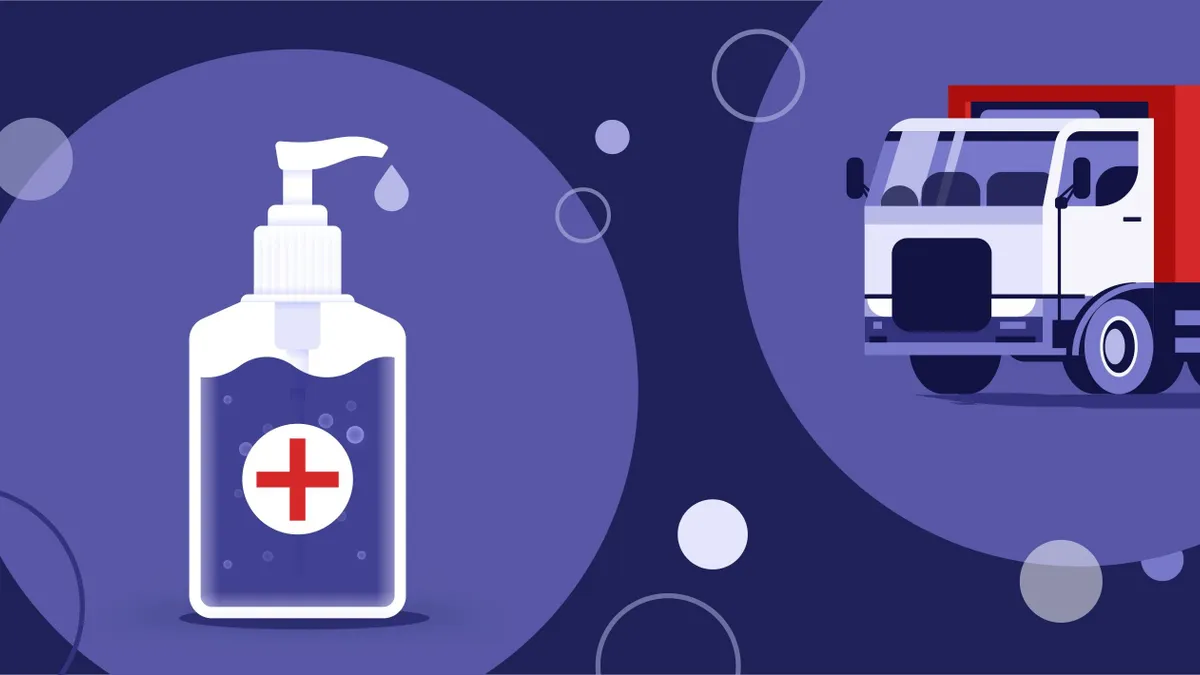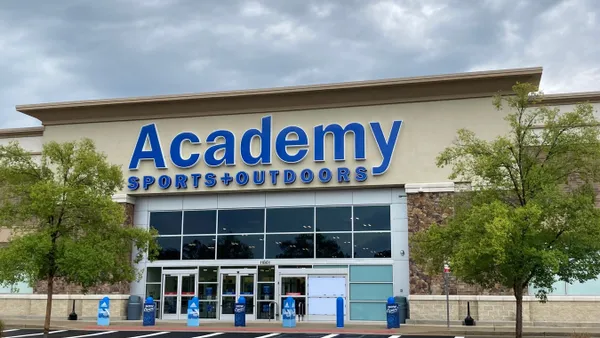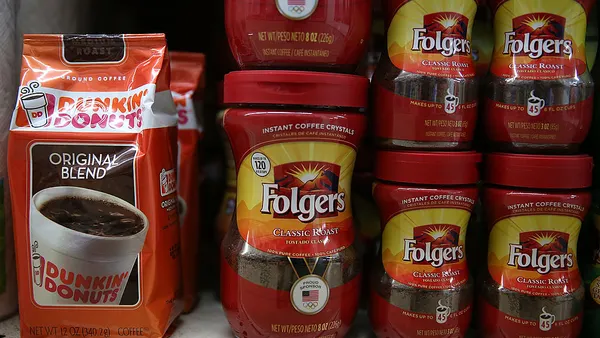In Rochester, New York, Black Button Distilling is churning out 9,000 bottles of hand sanitizer each week while continuing to offer its signature bourbon and gin. The distillery is used to producing the new product by now — but it wasn't always like this.
When hand sanitizer began disappearing from shelves across the country in March, it created new avenues of supply and demand. Workers on the front lines, from healthcare to trucking, needed it but couldn't find it. Nontraditional producers, including the small-batch maker, had an opportunity to fill the gap.
On March 16, Black Button was shutting down operations, anticipating a state-wide mandate that would keep employees and customers in their homes. But by March 19, the distillery had pivoted and produced 5,000 bottles of ethanol-based hand sanitizer.
"I think I would describe it as running an obstacle course, where each time you would turn the corner, there would be a new obstacle you had not seen 10 minutes before. We'd figure one out and a new one would pop up," Jason Barrett, president and head distiller at Black Button, told Supply Chain Dive. "It all has come together, but it didn't just fall into place for us."
Connecting new supply with new demand amid a backdrop of unprecedented circumstances required improvised supply chains. For Black Button, that meant leaning on existing relationships while forging new ones, and having the agility to conquer challenges as they appeared. And doing it all quickly.
Ramping up with new suppliers
During normal operations, Black Button produces 4,000 bottles of bourbon a week.
During the first week of hand sanitizer production, the distillery connected with a local hospital system in Rochester, New York for which it produced the first 5,000 bottles. One bottle of the ethanol-based solution contains the equivalent of about two bottles of vodka, Barrett said.
Then, word spread and new customers came calling. By the time week five ended, the distillery was at maximum production capacity, making 70,000 bottles of hand sanitizer a week.

Bourbon and hand sanitizer have two main ingredients in common: ethanol and water. But hand sanitizer requires some ingredients that bourbon does not, so the supply chains are different.
"Luckily, it was a supply chain that we're familiar with. But we did still have to come up with new suppliers, as well as change how we work with other ones," Barrett said. For large quantities of technical-grade ethanol, Black Button turned to Western New York Energy, a company with which it had worked on a couple studies but had never purchased from.
Figuring out how to procure large batches of sterile water was one of the "more interesting" challenges, Barrett said.
After running into a couple dead ends, the distillery asked Genesee Brewing Company for water. The two businesses had collaborated on product releases before, but buying water was something different entirely. It had its own logistical challenges. How were Black Button's empty water tanks going to get to the brewery? How long would the brewery need to fill the tanks and when would they need to be picked back up? How would any of this be able to take place without interrupting operations at Genesee Brewing Company? With the help of Black Button's logistics provider, Instant Express, they landed on a shuttle system that has the distillery picking up totes of water three mornings each week.
"Something as simple as the water — when you're trying to put a whole supply chain together in 72 hours — can become a real hurdle, because it has to be right or what you're making isn't right,” Barrett said.
Black Button is procuring glycerin from Fee Brothers, a local company that produces cocktail bitters. The two had done many cocktail classes together, but they didn't previously have a supplier relationship. For hydrogen peroxide, Black Button called on its cleaning-products supplier. But instead of its normal order, the distillery is bringing in drums of hydrogen peroxide every week. And a new product requires new packaging, so Black Button tapped TricorBraun as a new packaging supplier.
"Luckily, it was a supply chain that we're familiar with. But we did still have to come up with new suppliers, as well as change how we work with other ones."
Jason Barrett
President/Head Distiller, Black Button Distilling
"We only have 3,600 square feet in our production facility, most of which is taken up by equipment. Not only do we have to make this much, but we basically have to do just-in-time deliveries of incoming goods. We get some supplies twice a day because we can't fit more than that into the building," Barrett said. Most shipments of hand sanitizer must leave the plant within 90 minutes of being made, he said, as there is no storage space for back stock.
Producing 4,000 bottles of bourbon requires Black Button to run one shift, five days a week. To produce 70,000 bottles of hand sanitizer a week, the distillery runs two shifts, six days a week. This, it decided, is the maximum amount possible without jeopardizing workers' well-being.
Black Button used its smaller manual bottling line, because its big bottling line can't handle the potency of the hand sanitizer mix. That smaller line could produce 8,000 to 12,000 bottles of hand sanitizer a week. In recent weeks though, the distillery has purchased five additional manual lines and other supporting equipment, which allowed it to ramp up.
"It's a big logistical puzzle that most of the time works pretty well," Barrett said. "There probably isn't space for 20 pallets in the building. So, when you figure you've got incoming supplies and outgoing supplies, we've also then been utilizing our parking lot, a lot."
Meeting demand within the supply chain
Black Button originally reserved hand sanitizer for healthcare workers and public servants, unaware of the need within the supply chain itself.
"I don't think people realize how much trucking was involved [in relief efforts], how important it is," Robert Peckham, director of business development for Vnomics and a member of the Trucking Association of New York (TANY) board of directors, told Supply Chain Dive. "And in turn, we're sort of put lower in the priority list."
Leonard's Express, a trucking company based in Rochester, New York, was on alert before panic-buying peaked. One of its drivers had been to Washington state in February, where news of the coronavirus in the U.S. was initially focused. The driver tested negative for the virus, but the carrier started taking precautions for its 450 drivers. Then, New York City became an outbreak epicenter, an area to which Leonard's Express often hauls produce. Getting drivers hand sanitizer was a priority for Leonard's Express CEO Ken Johnson.
"We've never been in a situation where it's been so difficult to get [personal protective equipment] such as this, whether it's the hand sanitizer or the masks or gloves," Kendra Hems, president of TANY, told Supply Chain Dive in late April. "There's just such a demand across the country for it that it really is creating challenges.”
"I knew we were providing essential services, and that our services were needed, and our guys had to do what they were doing. But I couldn't find a way to help protect them."
Ken Johnson
CEO, Leonard's Express
Leonard's Express sent employees to local grocery stores and pharmacies to look for the product. On the rare occasion it was in stock, the store had limits on how many bottles each customer could purchase.
"We kept hitting roadblocks. Everybody was out of it, from our normal channels," Johnson told Supply Chain Dive in an interview. Even when word started getting around that distilleries were pivoting production to hand sanitizer, Johnson's path was still blocked. No distillery would sell to Leonard's Express, as many — including Black Button, which had just started producing hand sanitizer at the time — were reserving their stocks for healthcare professionals or only selling in their local markets.
"It was just very, very frustrating," Johnson said. "I knew we were providing essential services, and that our services were needed, and our guys had to do what they were doing. But I couldn't find a way to help protect them."
Johnson's frustrations eventually culminated in a Facebook "diatribe," he said. But it paid off. Peckham saw the post. He had connections at Black Button and made it his mission to get Leonard's Express the hand sanitizer the distillery was producing.
Peckham started conversations with Black Button, conveying the truck drivers' need for hand sanitizer. Within two weeks of Johnson's search, Leonard's Express received 700 bottles of Black Button hand sanitizer. Then, the floodgates opened.
"Within, I don't know, a day, I had TANY members from all over New York state replying to my inquiry, 'Does anybody need hand sanitizer?'" Peckham said. "[Black Button] probably sold 1,500 to 2,000 bottles in the first week and a half, just from our [members], at a minimum."
Along with procuring hand sanitizer, Johnson was able to procure 1,000 washable face masks from a custom tailor that pivoted operations to provide masks to drivers and office staff. He also got a hold of disposable masks for diesel technicians. In late-April, Johnson was struggling to find rubber gloves. "I think we've found our channels and hopefully those channels stay open," he said.
The old and new normal
Black Button was getting ready for an expansion before the pandemic occurred, so the distillery had enough of its normal inventory to make hand sanitizer for about 16 weeks before product availability would be impacted. But it was never in the cards for Black Button to permanently switch production to ethanol-based hand sanitizer.
"Although we're happy we're doing our part ... we also have to make sure we have a company to come back to when this is all over," Barrett said.
To that end, Black Button decided to go ahead with the seasonal release of its popular Lilac Gin, which typically occurs mid-May. The gin was distilled using different equipment in a different part of the building, so it didn't disturb hand sanitizer production.
For one week, the liquor needed to hit the bottling line, and Black Button was only able to produce 10,000 bottles of hand sanitizer. But Black Button worked with its hand sanitizer customers to anticipate needs and built a small reserve in the warehouse to help cover inventory.
"Although we're happy we're doing our part ... we also have to make sure we have a company to come back to when this is all over."

Jason Barrett
President/Head Distiller, Black Button Distilling
In the industry, it's typical for a business to request the quickest possible delivery from suppliers, Barrett said. Black Button likes to have its production schedule set and give suppliers 90-days notice, while having an idea of the schedule for the 90 days after that. Barrett said that amount of planning makes the distillery stand out to its suppliers, which enabled them to be more understanding when Black Button canceled most of its inbound supply orders for six months.
"We have very strong relationships with most of our vendors because of the artisanal nature of what we do," Barrett said. "This is the first time anything like this has ever happened, so they were all very understanding and helpful."
When Black Button is ready to bid farewell to hand sanitizer and return to normal production, one of the first steps will be a deep clean on the equipment. One of the hand sanitizer ingredients is denaturant, and the team worked with the supplier to write cleaning procedures to make sure the substance is fully removed.
Barrett estimated it would take six to eight weeks to return to full production of liquor, after cleaning and getting back on track with suppliers. "We won't be able to just flip that back on," he said.
Black Button has been producing 9,000 bottles a week for about a month now, as the original high demand has slowed. But Hems said hand sanitizer demand may not return to pre-pandemic levels any time soon.
"There's going to be a new normal," Hems said, "and we don't know yet moving forward how comfortable anyone is going to be, being out in the public and being around others and touching things."
This story was first published in our weekly newsletter, Supply Chain Dive: Operations. Sign up here.














